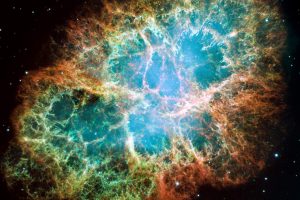In this handout from NASA in 2005, the mosaic image, one of the largest ever taken by NASA’s Hubble Space Telescope of the Crab Nebula, shows six-light-year-wide expanding remnant of a star’s supernova explosion. Japanese and Chinese astronomers witnessed this violent event nearly 1,000 years ago in 1054, together with, possibly, Native Americans. The orange filaments are the remains of the star and consist mostly of hydrogen. The rapidly spinning neutron star embedded in the center of the nebula is the dynamo powering the nebula’s eerie interior bluish glow. The blue light comes from electrons whirling at nearly the speed of light around magnetic field lines from the neutron star. The neutron star, the crushed ultra-dense core of the exploded star, ejects twin beams of radiation that appear to pulse 30 times a second due to the neutron star’s rotation. (Photo by NASA via Getty Images)
Hubble Space Telescope Releases The Largest Picture Of Crab Nebula
In this handout from NASA in 2005, the mosaic image, one of the largest ever taken by NASA's Hubble Space Telescope of the Crab Nebula, shows six-light-year-wide expanding remnant of a star's supernova explosion. Japanese and Chinese astronomers witnessed this violent event nearly 1,000 years ago in 1054, together with, possibly, Native Americans. The orange filaments are the remains of the star and consist mostly of hydrogen. The rapidly spinning neutron star embedded in the center of the nebula is the dynamo powering the nebula's eerie interior bluish glow. The blue light comes from electrons whirling at nearly the speed of light around magnetic field lines from the neutron star. The neutron star, the crushed ultra-dense core of the exploded star, ejects twin beams of radiation that appear to pulse 30 times a second due to the neutron star's rotation. (Photo by NASA via Getty Images)



